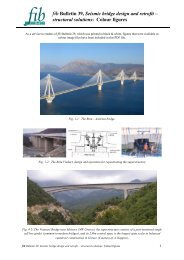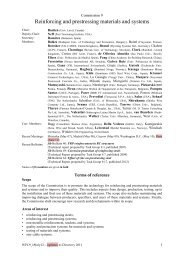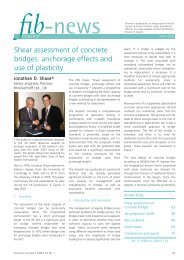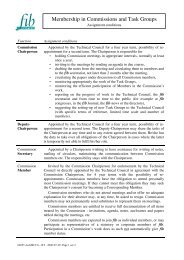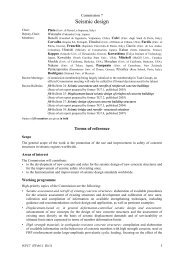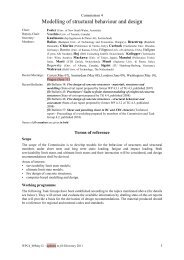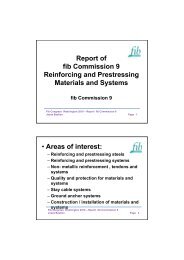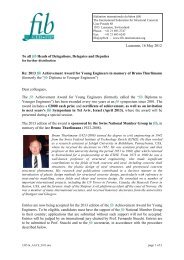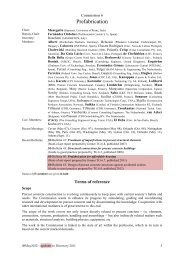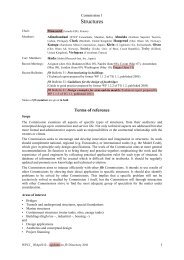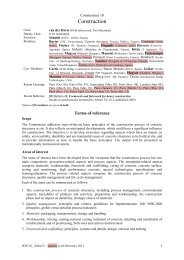The International Federation for Structural Concrete
The International Federation for Structural Concrete
The International Federation for Structural Concrete
Create successful ePaper yourself
Turn your PDF publications into a flip-book with our unique Google optimized e-Paper software.
Commission 8<br />
<strong>Concrete</strong><br />
Chair: Dehn (MFPA Leipzig, Germany)<br />
Deputy-Chair: Müller (Karlsruhe Inst. of Tech., Germany)<br />
Members: Beushausen (Univ. of Cape Town, South Africa), De Schutter (Ghent Univ., Belgium),<br />
Ferrara (Politecnico di Milano, Italy), Geiker (NTNU, Norway), Glavind (Danish<br />
Technological Institute, Denmark), Grünewald (TU Delft, <strong>The</strong> Netherlands), Helland (Skanska<br />
Norge AS, Norway), Lohaus (Leibniz Univ. Hannover, Germany), Mechtcherine (Technische<br />
Univ. Dresden, Germany), Silfwerbrand (CBI, Sweden), Ueda (Hokkaido Univ., Japan),<br />
Vandewalle (KU Leuven, Belgium), Walraven (TU Delft, <strong>The</strong> Netherlands)<br />
Recent Meetings: Cavtat (May 07), Amsterdam (May 08), London (May 09), Washington (May 10)<br />
Recent Bulletins: fib Bulletin 42: Constitutive modelling of high strength / high per<strong>for</strong>mance concrete<br />
(State-of-art report prepared by <strong>for</strong>mer TG8.2, published 2008)<br />
Names of fib members are given in bold<br />
Scope<br />
Terms of reference<br />
<strong>The</strong> aim of the Commission is to collect and to validate in<strong>for</strong>mation on the properties and the<br />
behaviour of the material concrete subjected to various types of loading and environmental conditions.<br />
<strong>The</strong> Commission focuses its attention both on classical types of concrete, in particular under unusual<br />
conditions, and on new types of concrete under all types of loadings and conditions. <strong>The</strong> properties of<br />
the concrete types considered should be <strong>for</strong>mulated in such a way that it is possible to derive<br />
behavioural models and design recommendations <strong>for</strong> practical applications.<br />
Areas of interest<br />
• durability and corrosion of concrete;<br />
• cements, concrete admixtures and additions;<br />
• constitutive laws <strong>for</strong> high per<strong>for</strong>mance concretes;<br />
• mechanical properties of concrete with recycled components;<br />
• properties and behavioral modeling of ultra-high strength concrete, lightweight concrete, selfcompacting<br />
concrete and fibre-rein<strong>for</strong>ced concrete;<br />
• environmental aspects of concrete;<br />
• aspects of mixing, execution and curing;<br />
• behaviour of concrete under very low and very high temperatures;<br />
• code-type modeling, in particular <strong>for</strong> the Model Code 2010;<br />
• per<strong>for</strong>mance-based specifications <strong>for</strong> concrete.<br />
<strong>The</strong>se activities need partially to be coordinated among other fib Commissions and international<br />
associations such as RILEM. Possibilities <strong>for</strong> joint Task Groups will be considered.<br />
Working programme<br />
• Task Groups will concentrate on the topics mentioned in the list above. <strong>The</strong>y are expected to first<br />
write state-of-the-art reports on the topics considered. To this aim they collect and evaluate the<br />
available in<strong>for</strong>mation and present it in a systematic way. If appropriate, chapters on existing<br />
practical application are added.<br />
• Proposals are made <strong>for</strong> <strong>for</strong>mulations of the behaviour of concrete which can be used in design<br />
recommendations. <strong>The</strong>se proposals should, if possible, be <strong>for</strong>mulated as extensions of the New<br />
Model Code.<br />
• <strong>The</strong> Commission follows current developments in the building industry and at the universities and<br />
can decide to take action with regard to:<br />
• defining new areas of study;<br />
• recommending actions to resolve and prevent problems.<br />
WPC8_22Nov12 – updates to fib Directory 2011 1
Task Group<br />
TG 8.3 Fibre rein<strong>for</strong>ced concrete<br />
Convener: Vandewalle (KU Leuven, Belgium)<br />
Secretary: Lambrechts (Bekaert s.a., Belgium)<br />
Members: Balázs (Budapest Univ. of Technology and Economics, Hungary), Banthia (Univ. of British<br />
Columbia, Canada), Barros (Univ. do Minho, Portugal), Criswell (Colorado State Univ., USA),<br />
Dehn (MFPA Leipzig, Germany), Destree (ArcelorMittal, Belgium), Di Prisco (University of<br />
Milano, Italy), Falkner (Ingenieurbüro Dr. Falkner, Germany), Gettu (Indian Institute of<br />
Technology Chennai, India), Kanstad (<strong>The</strong> Norwegian Univ. of Science & Tech. , Norway),<br />
Krstulovic-Opara (ArupEnergy, Houston, USA), Kusterle (Univ. Innsbruch, Austria),<br />
Löfgren (Arup Materials Consulting, United Kingdom), Lublóy (Budapest Univ. of Tech.,<br />
Hungary), Mari Bernat (Univ. Politécnicade Catalunya, Spain), Massicotte (Univ. of<br />
Montreal, Canada), Ono (Kyoto Univ., Japan), Pfyl (Pfyl Partner AG, Switzerland), Plizzari<br />
(Univ. of Brescia, Italy), Rossi (LCPC, France), Serna Ros (Univ. Politecnica Valencia, Spain),<br />
Silfwerbrand (CBI, Sweden), Stang (Technical University of Denmark, Denmark), Szabo<br />
(Budapest Univ. of Technology and Economics, Hungary), Tatnall (Synthetic Industries Inc.,<br />
USA), Trottier (Dalhousie University, Halifax, Canada), Vitt ( Bekaert GmbH, Germany),<br />
Walraven (Delft Univ. of Technology, <strong>The</strong> Netherlands)<br />
Corr. Members: Parra-Montesinos (Univ. of Michigan, USA), Mobasher (Arizona State Univ., USA)<br />
Recent Meetings: Leipzig (Nov 06), Atlanta (Apr 07), Paris (Nov 07), Brussels (Feb 08 – together with<br />
T8.6), Valencia (Mar 08), Paris (June 08 - with TG 8.6), Chennai (Sept 08), Budapest<br />
(Mar 09), Brussels (Jul 09), Milan (Oct 09), Guimaraes (Apr 10), Leuven (Jan 11), Milan<br />
(May 11), Oslo (May 12)<br />
Names of fib members are given in bold<br />
Terms of reference<br />
<strong>The</strong> Task Group collects and validates in<strong>for</strong>mation on the behaviour of fibre rein<strong>for</strong>ced concrete<br />
subjected to various types of loading and environmental conditions.<br />
Concerning steel fibre rein<strong>for</strong>ced concrete, the group will continue the work of the RILEM technical<br />
committee TC162-TDF Test and Design Methods <strong>for</strong> Steel Fibre Rein<strong>for</strong>ced <strong>Concrete</strong>.<br />
TG 8.3 will develop recommendations and identify research needs <strong>for</strong> all types of fibres. In the fib<br />
Model Code 2010 (extending Model Code 90), the material ‘Fibre Rein<strong>for</strong>ced <strong>Concrete</strong>’ is included.<br />
Since both strain hardening and strain softening FRC are to be considered TG 8.3 and TG 8.6 have<br />
prepared the relevant texts together. Also an fib bulletin will be written to give more background<br />
in<strong>for</strong>mation and details.<br />
Task Group<br />
TG 8.6 Ultra high per<strong>for</strong>mance fibre rein<strong>for</strong>ced concrete<br />
Convener: Walraven (Delft Univ. of Technology, <strong>The</strong> Netherlands)<br />
Members: Aarup (CRC Technology, Denmark), Behloul (Lafarge, France), Bunje (Kassel Univ. and<br />
Fehling & Jungmann GmbH, Germany), Dehn (MFPA Leipzig, Germany), Denarié (EPF<br />
Lausanne, Switzerland), Di Prisco (University of Milano, Italy), Fehling (IBB Fehling +<br />
Jungmann GmbH, Germany), Greiner (Bilfinger + Berger AG, Germany), Grünewald (TU Delft,<br />
<strong>The</strong> Netherlands), Jungwirth (Schmitt Stumpf Frühauf and Partner, Germany), Lagerblad (CBI,<br />
Sweden), Ma (Leipzig Univ., Germany), Muttoni (EPF Lausanne, Switzerland), Redaelli<br />
(Perreten et Milleret, Switzerland), Resplendino (Ministry of Transport, France), Rossi (LCPC,<br />
France), Schmidt (Kassel Univ., Germany), Shionaga (IHI Co. Ltd., Japan), Simon (Eiffage,<br />
France), Skazlic (Univ. of Zagreb, Croatia), Stürwald (Kassel Univ., Germany), Thibaux<br />
(Eiffage, France), Tue (Graz Univ., Austria), Weisse (Ingenieurbaukontor Schreiber & Partner<br />
WPC8_22Nov12 – updates to fib Directory 2011 2
Leipzig GmbH, Germany)<br />
Corr. Members: Braam (Delft Univ., <strong>The</strong> Netherlands), Brühwiler (EPF Lausanne, Switzerland), Causse<br />
(Vinci, France), Chanvillard (Lafarge, France), Gambarova (Univ. Milano, Italy), Graybeal<br />
(FHWA, USA), Holschemacher (Univ. of Applied Sciences, Leipzig, Germany), Kaptijn<br />
(Ministry of Traffic and Transport, <strong>The</strong> Netherlands), Katagiri (Taiheyo Cement, Japan),<br />
Lambrechts (Bekaert s.a., Belgium), Leutbecher (Kassel Univ., Germany), Sato (Hokkaido<br />
Univ., Japan), Toutlemonde (LCPC, France), Ulm (Massachusetts Institute of Technology, USA)<br />
Recent Meetings: Milano (May 07), Marseille (Nov. 07), Kassel (Mar. 08), Varenna (Sept. 08), Marseille<br />
(Nov. 09), Paris (May 10), Milan (Oct. 10), Delft (Jan. 11)<br />
Names of fib members are given in bold<br />
Terms of reference<br />
<strong>The</strong> Task Group will write design recommendations <strong>for</strong> concretes with a strength > 120 N/mm 2 ,<br />
applicable to concrete with fibres of various nature, such as steel, polyacrylic, polypropylene etc. or<br />
combinations thereof.<br />
<strong>The</strong> work of Task Group 8.6 will be co-ordinated with the work of fib Task Group 8.3 Fibre<br />
rein<strong>for</strong>ced concrete that develops guidelines <strong>for</strong> fibre rein<strong>for</strong>ced concrete in strength classes ≤ 120<br />
N/mm 2 . Through common members there is also co-ordination with the work of the RILEM Technical<br />
Committee on High Per<strong>for</strong>mance Fibre Rein<strong>for</strong>ced Cementitious Composites (TC HFC).<br />
<strong>The</strong> <strong>for</strong>mat will be as close as possible to the <strong>for</strong>mat of the Model Code 2010 <strong>for</strong> concrete structures<br />
presently under preparation by fib SAG 5 so that both can be used in a complementary way.<br />
Task Group<br />
TG 8.7 Code-type models <strong>for</strong> concrete behaviour<br />
Convener: Müller (Karlsruhe Institute of Technology, Germany)<br />
Secretary Burkart (Karlsruhe Institute of Technology, Germany)<br />
Members: Cervenka (Cervenka Consulting, Czech Republic), Curbach (Technische Univ. Dresden,<br />
Germany), Dehn (MFPA Leipzig, Germany), Gehlen (Univ. München, Germany), Glavind<br />
(Danish Technological Institute, Denmark), Gylltoft (Chalmers Univ. of Technology, Sweden),<br />
Helland (Skanska Norge AS, Norway), Koenders (Delft Univ. of Technology, <strong>The</strong><br />
Netherlands), Mechtcherine (Technische Univ. Dresden, Germany), Reinhardt (Univ.<br />
Stuttgart, Germany), Walraven (Delft Univ. of Technology, <strong>The</strong> Netherlands)<br />
Recent Meetings: Karlsruhe (May 08), Stuttgart (Nov. 08), Dresden (April 09)<br />
Names of fib members are given in bold<br />
Terms of reference<br />
Similar to the Model Code 90, the fib Model Code 2010 will include a chapter on the constitutive and<br />
durability related behaviour and properties of concrete. For the time being, this chapter in MC 90 deals<br />
primarily with ordinary structural concrete. Due to the great progress in concrete technology in recent<br />
years, new types of concrete are produced more and more in practice. However, there is still a lack in<br />
compiling the gained knowledge and in particular in presenting the behaviour of these concretes in a<br />
code-type manner. In addition, new concrete models have been developed in the recent past which<br />
have to be evaluated critically in view of writing the Model Code 2010.<br />
<strong>The</strong> major target of the Task Group consists in developing a code-type presentation of the<br />
constitutive and durability related behaviour of concrete to be included in the new model code. This<br />
target comprises the compilation and evaluation of available concrete models and the development of<br />
new models complying with the framework of the fib Model Code 2010. <strong>The</strong> obtained results will be<br />
presented in a Bulletin and will directly contribute to the work of fib SAG 5.<br />
WPC8_22Nov12 – updates to fib Directory 2011 3
Task Group<br />
TG 8.8 <strong>Structural</strong> design with flowable concrete<br />
Conveners: Grünewald (TU Delft, <strong>The</strong> Netherlands), Ferrara (Politecnico di Milano, Italy)<br />
Members:<br />
(tentative)<br />
Barragan (BASF, Italy), Barros (Univ. of Minho, Portugal), Behloul (Lafarge, France), Beitzel<br />
(IBU Trier, Germany), Billberg (CBI Stockholm, Sweden), Dehn (MPFA Leipzig, Germany),<br />
Den Uijl (TU Delft, <strong>The</strong> Netherlands), Di Prisco (Politecnico di Milano, Italy), Domone<br />
(Univ. College London, UK), Freytag (TU Graz, Austria), Geiker (DTU Lyngby, Denmark),<br />
Gettu (Indian Institute of Technology Madras, India), Hammer (Sintef, Norway), Kanstad<br />
(NTNU, Norway), Laranjeira (UP Catalunya, Spain), Martinie (LCPC, France), Obladen<br />
(Strukton, <strong>The</strong> Netherlands), Roussel (LCPC, France), Sato (Hakkaido Univ., Japan), Schmidt<br />
(BAM, Germany), Sonebi (Queen's Univ. Belfast, UK), Stähli (Concretum Zürich, Switzerland),<br />
Stang (DTU Lyngby, Denmark), Vandewalle (Katholieke Universiteit Leuven, Belgium),<br />
Walraven (TU Delft, <strong>The</strong> Netherlands), Zilch (Techn. Univ. München, Germany)<br />
Recent Meetings: Ghent (April 09), Milan (Jan. 10), Montreal (Sept. 10)<br />
Names of fib members are given in bold<br />
Terms of reference<br />
Scope<br />
Flowable concretes (self-compacting or highly flowable) have evolved to a commonly applied<br />
building material. In spite of significant experience with flowable concrete problems still occur during<br />
casting and the service life of concrete structures. <strong>The</strong> flow (initiated by vibration and/or the weight of<br />
concrete) can affect the structural behaviour of hardening or hardened concrete. In order to obtain a<br />
high flowability the mixture composition has to be adjusted and optimised. <strong>The</strong> effect of fibres on the<br />
characteristics of flowable concrete will be considered in a subgroup of fib TG 8.8.<br />
<strong>The</strong> main objectives of fib Task Group 8.8 are to write a state-of-the-art report and a recommendation<br />
on the structural design with flowable concretes. <strong>The</strong> per<strong>for</strong>mance of a structure with flowable<br />
concrete depends not only on material characteristics, but also on the production method and the<br />
structure itself. Areas of structural design where flowable concretes differ from traditional vibrated<br />
concrete have to be identified. Four aspects will be considered in order to describe structural<br />
behaviour:<br />
- mechanical characteristics<br />
- local effects (i.e. close to the concrete surface or rein<strong>for</strong>cement bars)<br />
- effects of orientation/segregation due to the flow/vibration<br />
- how to optimise the mixture composition of and production techniques <strong>for</strong> flowable concrete<br />
Working programme<br />
fib TG 8.8 consists of two subgroups: 'plain concrete' and 'fibre rein<strong>for</strong>ced concrete'; both groups meet<br />
together. <strong>The</strong> second group will focus on the effect of orientation and distribution of fibres on the<br />
characteristics of flowable concrete, whereas other relevant aspects will be considered by the first<br />
group. <strong>The</strong> work is divided in three phases: 1) orientation, 2) compilation and comparison (output:<br />
state-of-art report) and 3) translation (output: recommendation).<br />
WPC8_22Nov12 – updates to fib Directory 2011 4
Task Group<br />
TG 8.9 Aesthetics of concrete surfaces<br />
Convener: Lohaus (Leibniz Univ. Hannover, Germany)<br />
Secretary Werner (Leibniz Univ. Hannover, Germany)<br />
Members: Barragan (BASF, Italy), Boska (TU Darmstadt, Germany), Casals (Oficina tècnica d'enginyeria<br />
civil, Spain), Dehn (MFPA Leipzig, Germany), De Weerdt (SINTEF, Norway) Eide (SINTEF,<br />
Norway), Gjerde (Victoria School of Wellington, New Zealand), Goldammer (Deutscher Beton-<br />
und Bautechnik-Verein E.V., Germany), Heck (TU Graz, Austria), Hellström (Swedish <strong>Concrete</strong><br />
Association, Sweden), Hierlein (Fachvereinigung Deuscher Betonfertigteilbau e.V. , Germany),<br />
Hofstadler (TU Graz, Austria), Karman (Ecoratio, Netherlands), Motzko (Technische Univ.<br />
Darmstadt, Germany), Pacios (ETS Ingenieros Industriales – UPM, Spain), Reinisch (Doka<br />
GmbH, Austria), Tadros (SPECO Engineering Ltd., Canada), van de Riet (Ecoratio,<br />
Netherlands),<br />
Recent Meetings: Hannover (Dec. 09), Darmstadt (July 10), Darmstadt (Feb 11)<br />
Names of fib members are given in bold<br />
Terms of reference<br />
Scope<br />
<strong>The</strong> notion of attractive concrete is subjective and varies according to the viewer. In order to have a<br />
basis <strong>for</strong> the work of TG 8.9, it is necessary to limit the requirements regarding the appearance of<br />
concrete surfaces. Because exposed concrete has been established in recent years by well-known<br />
architects as having a homogenous and smooth appearance, the work will be focused on this kind of<br />
visible concrete surfaces.<br />
An attractive concrete surface is observed within the context of the surfaces of the whole building. <strong>The</strong><br />
resulting impression depends considerably on the viewing distance and lighting conditions. <strong>The</strong>re<strong>for</strong>e<br />
the utilization of the building is important when evaluating a concrete surface. <strong>The</strong> realization of an<br />
exposed concrete surface is influenced by many different factors, including concrete technology,<br />
concrete <strong>for</strong>mwork and <strong>for</strong>mwork material, the application of a releasing agent, the method of<br />
operation on-site, logistical conditions during transportation of the concrete and concreting, as well as<br />
climatic influences and the coordination of all persons involved in the building process.<br />
Objectives<br />
TG 8.9 will <strong>for</strong>mulate a state of the art report how exposed concrete is defined and built. <strong>The</strong> final aim<br />
is to create a generally accepted recommendation or guideline <strong>for</strong> exposed concrete with a<br />
homogenous appearance. This generally accepted recommendation or guideline will be characterized<br />
by classifying exposed concrete in different categories. <strong>The</strong> limit of its objective per<strong>for</strong>mance will be<br />
considered as well as the consequences on the ef<strong>for</strong>t on-site and the planning of structural framework.<br />
Work programme<br />
Phase 1: it will first be necessary to collect and evaluate test results and practical experience with<br />
exposed concrete. <strong>The</strong> influences on the appearance of a visible surface should be discussed and it<br />
should be assessed in how far they can be controlled in the planning process and during the execution.<br />
<strong>The</strong> results will have to be summarized in a state of the art report.<br />
Phase 2: Based on the results of phase 1 as well as on already existing national regulations and<br />
recommendations, categories <strong>for</strong> exposed concrete surfaces will be developed. <strong>The</strong>se categories will<br />
result in a generally accepted recommendation or guideline <strong>for</strong> exposed concrete with a homogenous<br />
and smooth appearance. <strong>The</strong> kind of publication of this guideline has to be discussed, possibly as<br />
recommendations <strong>for</strong> the classification of attractive concrete surfaces.<br />
WPC8_22Nov12 – updates to fib Directory 2011 5
Task Group<br />
TG 8.10 Per<strong>for</strong>mance-based specifications <strong>for</strong> concrete<br />
Conveners: Beushausen (University of Cape Town (UCT), South Africa), Dehn (MFPA Leipzig,<br />
Members<br />
(tentative):<br />
Germany)<br />
Recent Meetings: Leipzig (Jan 11)<br />
Names of fib members are given in bold<br />
Terms of reference<br />
Alexander (Univ. of Cape Town, South Africa), Altmann (TU Dresden, Germany), De Belie<br />
(Univ. of Ghent, Belgium), De Schutter (Univ. of Ghent, Belgium), Fennis (TU Delft, <strong>The</strong><br />
Netherlands), Geiker (TU Denmark), Goncalves LNEC, Portugal), Gulikers (RWX, <strong>The</strong><br />
Netherlands), Haist (Karlsruhe Institute of Technology, Germany), Hammer (Sintef, Norway),<br />
Hooton (Univ. of Toronto, Canada), König (MFPA Leipzig, Germany), Mechtcherine (TU<br />
Dresden, Germany), Müller (Karlsruhe Institute of Technology, Germany), Strauss (BOKU<br />
Vienna, Austria), Torrent (Holcim, Switzerland), Walraven (TU Delft, <strong>The</strong> Netherlands),<br />
Wendner (BOKU Vienna, Austria), Ye (TU Delft, <strong>The</strong> Netherlands),<br />
Scope<br />
Recent advances in cementitious materials technology - as well as the growing use of recycled<br />
materials - have supported the increasing use of modern types of concrete which have been<br />
specifically developed <strong>for</strong> an application case but which are not covered in existing codes and<br />
specifications.<br />
Traditional descriptive/prescriptive specifications regard concrete as a mix of different ingredients<br />
leading to an apparently identical per<strong>for</strong>mance knowing that concrete can vary widely. In contrast,<br />
per<strong>for</strong>mance-based specifications set demands on how the concrete will be used rather than on how it<br />
needs to be composed.<br />
Traditional requirements <strong>for</strong> constituent materials, limiting water/binder ratios and cement contents<br />
are often not applicable <strong>for</strong> modern construction. With the advancement of testing methods <strong>for</strong> fresh<br />
and hardened concrete properties, a per<strong>for</strong>mance-based design and specification of concrete and<br />
concrete structures is approaching <strong>for</strong> most applications and already frequently applied. In addition to<br />
compressive strength and durability, other properties (e.g. elastic/plastic de<strong>for</strong>mations, fresh concrete<br />
properties, thermal characteristics during and after hardening, strength development, ductility, crack<br />
resistance, etc.) are relevant and need to be considered.<br />
Also aspects of quality assurance and sustainability must be taken into account.<br />
Objectives<br />
• Provision of concrete technological background and posing of practical questions<br />
• Provision of concrete technological and structural expertise<br />
• Development of (new) design concepts <strong>for</strong> per<strong>for</strong>mance-based concretes/constructions and transfer<br />
of the concepts into practice<br />
Working programme<br />
• A kick-off meeting and a workshop were held in January 2011 (together with RILEM TC 230-PSC:<br />
Per<strong>for</strong>mance-based specifications and control of concrete durability, fib Commissions 3 and 5).<br />
• <strong>The</strong> duration of the TG is set <strong>for</strong> four years whereby the work will be subdivided into three phases:<br />
- Orientation (definition of achievable short-, medium- and long-term goals)<br />
- Preparation of a state-of-the-art review on per<strong>for</strong>mance-based specifications and testing methods<br />
- Preparation of concrete technological and structural design recommendations<br />
Since there is a lack of available knowledge and experience <strong>for</strong> per<strong>for</strong>mance-based design methods <strong>for</strong><br />
concrete, TG 8.10 can be a common base <strong>for</strong> the initiation of national and international collaborations<br />
and research projects leading to pre-normative or even normative specifications (inclusion in<br />
codes/standards).<br />
WPC8_22Nov12 – updates to fib Directory 2011 6
Task Group<br />
TG 8.11 Fire resistant concretes and cementitious<br />
composites <strong>for</strong> tunnel construction<br />
Conveners: Dehn (MFPA Leipzig GmbH, Germany), Neumann (MFPA Leipzig GmbH, Germany)<br />
Members To be announced<br />
Scope<br />
In research and practice - both in the private and public sector – an important requirement is to have<br />
in<strong>for</strong>mation about concretes and cementitious composites which show a significant resistance against<br />
extremely high temperatures and temperature gradients as they can occur during tunnel fire scenarios.<br />
<strong>The</strong>re<strong>for</strong>e, fib Task Group 8.11 “Fire resistant concretes and cementitious composites <strong>for</strong> tunnel<br />
construction” intends to prepare a Technical Report that will be a collection of available mix designs<br />
<strong>for</strong> concretes and cementitious composites in terms of their per<strong>for</strong>mances in fire based on<br />
experimental studies and/or real-life experiences. TG 8.11 will intensively cooperate with fib<br />
Commission 1 and fib WG 4.3-5 on “Fire Design of <strong>Concrete</strong> Tunnels”.<br />
Objectives<br />
• Summary of physical, chemical, thermo-hydraulic/-mechanical and technological background<br />
in<strong>for</strong>mation <strong>for</strong> fire resistant concretes and cementitious composites<br />
• Collection of available mix designs <strong>for</strong> concretes and cementitious composites<br />
Working programme: <strong>The</strong> planned duration of TG 8.11 is three years.<br />
Task Group<br />
TG 8.12 Constitutive laws <strong>for</strong> concretes with supplementary<br />
cementitious materials<br />
Conveners: Martius-Hammer (SINTEF, Norway), Justnes (SINTEF, Norway)<br />
Members Brameshuber (RWTH, Germany), Andrade (Instituto Eduardo Torroja, Spain), Bier (TU<br />
Bergakademie Freiberg, Germany), De Schutter (Ghent Univ., Belgium), Dehn (MFPA<br />
Leipzig GmbH, Germany), Denarie (EPF Lausanne, Switzerland), Fidjestol (Elkem ASA ,<br />
Norway), Helland (Skanska Norge AS, Norway), Hooton (Univ. of Toronto, Canada),<br />
Lagerblad (CBI, Sweden), Pade (Danish Technological Institute, Denmark), Visser (TNO<br />
Built Environ. & Geosciences, Netherlands), Vogt (CBI BetongInstitutet, Sweden), Vollpracht<br />
(RWTH, Germany), Ye (Delft Univ. of Technology, Netherlands)<br />
Recent Meetings: Leipzig (Nov 11), Cyprus (March 12)<br />
Names of fib members are given in bold<br />
Terms of reference<br />
Scope<br />
<strong>The</strong> use of Supplementary Cementitious Materials (SCM) as a binder in concrete is increasing driven<br />
mainly by the concrete industry’s need to make concrete more environmentally friendly and in<br />
particular to meet requirements <strong>for</strong> lower CO2-emissions. Today’s codes <strong>for</strong> concrete and concrete<br />
structures allow the use of SCM but limit which materials can be used and the amount of SCM (e.g.<br />
fly ash, silica fume, blast furnace slag, natural pozzolans, fine powders, etc.). TG 8.12 there<strong>for</strong>e<br />
intends to gather available in<strong>for</strong>mation about SCM - even <strong>for</strong> lesser known types - and prepare the<br />
basis <strong>for</strong> an extension of fib MC 2010, including the assessment of SCM to verify, validate and extend<br />
the constitutive laws/models when SCM are used. <strong>The</strong> work will also provide input to fib SAG8<br />
“Sustainability”.<br />
WPC8_22Nov12 – updates to fib Directory 2011 7
Terms of reference<br />
<strong>The</strong> target duration is 4 years, with two meetings per year. <strong>The</strong> members will be recruited from both<br />
academia and industry; furthermore the TG will cooperate with the new RILEM committee “TC SCM<br />
Hydration and microstructure of concrete with supplementary cementitious materials” and fib TG 8.10<br />
“Per<strong>for</strong>mance based specifications”. <strong>The</strong> work will include review of literature and ongoing research<br />
in the field, codes and recommendations, as well as already-existing constitutive relations and models.<br />
Objectives<br />
<strong>The</strong> group aims to draft a state-of-the-art report addressing the items in chapters 5.1 (“Materials -<br />
<strong>Concrete</strong>”) and 7.8 (“Design -Verification of limit states associated with durability) of MC2010. <strong>The</strong><br />
constitutive relations can be <strong>for</strong>mulated as in, and assessed in relation to compliance with those given<br />
in MC2010.<br />
<strong>The</strong> subchapters may contain assessment of the validity of material laws in the two above mentioned<br />
chapters in MC2010 are valid <strong>for</strong> SCM, based on existing knowledge. If not valid, modifications may<br />
be suggested based on an overview of work to develop or modify material laws <strong>for</strong> SMC. This may<br />
lead to the results: 1) MC2010 models are valid, 2) other existing laws specially made <strong>for</strong> SMC are<br />
valid, 3) material laws need to be further investigated or developed.<br />
Working Programme<br />
• Start-up meeting in October 2011<br />
• Joint RILEM TG SCM-meeting.<br />
• Second meeting organised as an internal workshop to plan the further work in the TG; also to<br />
prepare list of STAR-content including authors.<br />
• Biannual meetings to present and discuss new knowledge as prepared in draft chapters.<br />
• Intermediate reporting in <strong>Structural</strong> <strong>Concrete</strong> and/or other journals/conferences.<br />
• Final publication as an fib bulletin, state-of-the-art report and other journals/conferences<br />
WPC8_22Nov12 – updates to fib Directory 2011 8



